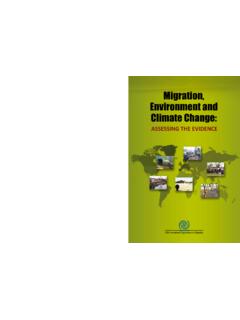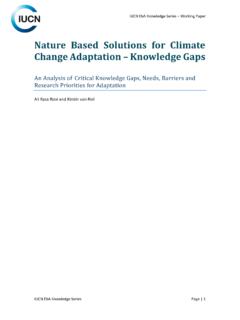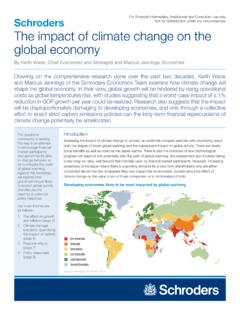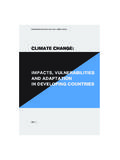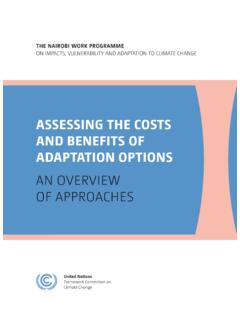Transcription of Health Impacts Climate Change - Centers for Disease ...
1 PREPARING FOR THE REGIONAL Health Impacts OF Climate Change IN THE UNITED STATES A summary of Health effects, resources, and adaptation examples from Health departments funded by CDC s Climate and Health Program July 2020 / Climate and Health Program 2 ContentsExecutive Summary ..3 Background3 Regions6 Alaska7 Hawaii and Pacific Islands10 Midwest 13 Northeast16 Northern Great Plains 20 Northwest22 Southeast 25 Southern Great Plains Caribbean 33 Conclusion36 Selected Links and Resources36 Appendix: Explanation of Graphics for Accessibility363 Executive SummaryEach region of the United States experiences Climate Change and its Impacts on Health differently, due to the regions location-specific Climate exposures and unique societal and demographic characteristics. The Centers for Disease Control and Prevention (CDC) Climate and Health Program supports states, counties, cities, tribes, and territories to assess how Climate Change will affect their community, identify vulnerable populations, and implement adaptation and preparedness strategies to reduce the Health effects of Climate Change .
2 This document describes the various Health Impacts Climate Change will have on different regions of the United States as outlined in the Fourth National Climate Assessment (NCA4), actions taken by the CDC Climate and Health Program s Health department partners to prepare for and respond to Climate Change in their communities, and relevant tools and Change , together with other natural and human-made Health stressors, influences human Health and Disease in numerous ways. Some existing Health threats will intensify and new Health threats will emerge ( ). For example, changes in temperature and precipitation are increasing Health risks associated with wildfire and ground-level ozone pollution. Rising air and water temperatures and more intense extreme events are expected to shift exposure to waterborne and foodborne diseases, affecting food and water safety. With continued warming, cold-related deaths are projected to decrease and heat-related deaths are projected to increase, and in most regions, increases in heat-related deaths are expected to outpace reductions in cold-related deaths.
3 The frequency and severity of allergic illnesses, including hay fever, are expected to increase as a result of shorter winters and earlier and longer pollen seasons. Climate Change is also projected to alter the geographic range and distribution of insects and pests, potentially exposing more people to ticks and mosquitoes that carry the agents that cause diseases like Lyme Disease , Zika, West Nile and dengue. Communities in the Southeast, for example, are particularly vulnerable to the combined Health Impacts from heat and flooding, which can result in large populations of nuisance mosquitoes and potential Disease risk. Finally, extreme weather and Climate -related events can have lasting mental Health consequences in affected communities, particularly if they result in degradation of livelihoods or community relocation. For more information on the Health Impacts of Climate Change in the United states, see the Health chapter of the fourth National Climate Assessment: of Climate Change on Human Health Climate Change Impacts a wide range of Health outcomes.
4 This image illustrates some of the most significant components of Climate Change (rising temperatures, more extreme weather, rising sea levels, and increasing carbon dioxide levels), their effect on exposures, and the subsequent Health outcomes that can result from these changes in exposures. Source: For accessibility see appendix, page 36. RISING MORE EXTREME RISING INCREASING TEMPERATURES WEATHER SEA LEVELS CO LEVELS4 Importantly, not everyone is equally at risk. The Impacts on Health due to Climate Change are both place-specific and path-dependent, meaning the Impacts of Climate Change depend on where you are and who you are, as there are varying degrees of Climate exposure and differences in individual and societal characteristics that can either protect you or make you more vulnerable to the Impacts of Climate Change .
5 For example, populations including older adults, children, low-income communities, and some communities of color are often disproportionately affected by, and less resilient to, the Health Impacts of Climate Change . Adaptation and mitigation policies and programs help individuals, communities, and states prepare for the risks of a changing Climate and reduce the number of injuries, illnesses, and deaths from Climate -related Health s Climate and Health Program is the national leader in empowering communities to protect human Health from a changing Climate . Beginning in 2010, the Climate and Health Program implemented the Climate -Ready States and Cities Initiative (CRSCI) to help state and city Health departments prepare for and respond to the Health effects that a changing Climate may bring to their communities. Sixteen states and two cities are funded to implement the five-step Building Resilience Against Climate Effects (BRACE) framework to identify likely Climate Impacts in their communities, potential Health effects associated with these Impacts , and their most at-risk populations and locations so that they can then develop and implement Health adaptation plans and address gaps in critical public Health functions and services.
6 For more information see: sequential steps comprise the BRACE frameworkThe Building Resilience Against Climate Effects (BRACE) framework is a five-step process that allows Health officials to develop strategies and programs to help communities prepare for the Health effects of Climate Change . Accessibility source: Step 1: Anticipate Climate Impacts and assessing VulnerabilitiesIdentify the scope of Climate Impacts , associated potential Health outcomes, and populations and locations vulnerable to these Health 2: Project the Disease BurdenEstimate or quantify the additional burden of Health outcomes associated with Climate 3: Assess Public Health InterventionsIdentify the most suitable Health interventions for the identified Health Impacts of greatest 4: Develop and Implement a Climate and Health Adaptation PlanDevelop a written adaptation plan that is regularly updated. Disseminate and oversee implementation of the 5: Evaluate Impact and Improve Quality of ActivitiesEvaluate the process.
7 Determine the value of information attained and activities Climate and Health Program also supports tribes, territories, and other communities that are not part of the Climate -Ready States and Cities Initiative (CRSCI) through the Building Capacity of the Public Health System to Improve Population Health through National, Nonprofit Organizations program managed by CDC s Center for State, Tribal, Local and Territorial Support (CSTLTS). Funded partners include the National Indian Health Board (NIHB) Climate -Ready Tribes Initiative; the Association of State and Territorial Health Officials (ASTHO) Climate -Ready Territories Initiative; the Council for State and Territorial Epidemiologists (CSTE); the National Environmental Health Association (NEHA); and the National Association of County and City Health Officials (NACCHO).Jurisdictions funded or previously funded by the CDC Climate and Health ProgramThis map highlights the states, cities, counties, tribes, and territories that have received funding and technical assistance from the CDC Climate and Health Program directly and through partnerships with other organizations.
8 For accessibility see appendix, page 36. Lummi NationClackamas CountyGreenville RancheraSan FranciscoAlameda CountySan Mateo CountyKaw NationWAORCAAZFLNCILWIMIMDRIMANHNYMEVTMN New OrleansNew York CityBostonSeneca Nationof IndiansMarquette CountyVillage of WainwrightSitka Tribe of Virgin IslandsPala Band ofMission IndiansFederated Statesof MicronesiaCommonwealthof the NorthernMariana IslandsBlackfeet NationWinnebago Tribe of NebraskaSwinomishIndian Tribal Community6 RegionsOutlined on the following pages are the unique Climate -related Health Impacts for each region of the United States (as defined by the Fourth National Climate Assessment) and relevant highlights of actions taken by the CDC Climate and Health Program s Health department partners to prepare for and respond to Climate Change in their communities. The Climate Impacts described in each region are not comprehensive, as additional threats may exist that were not included in the Fourth National Climate Assessment.
9 This document synthesizes the Impacts that are directly Health -relevant, but is not meant to be all-encompassing. In addition, the descriptions of local adaptation activities are not comprehensive. A variety of Climate -relevant Health adaptation activities that are not funded by CDC are taking place across the country, and are not reflected in this and PACIFIC CARIBBEANSOUTHWESTNORTHERN GRE AT PL AINSNORTHWESTSOUTHERN GRE AT PL AINSMIDWESTNORTHEASTSOUTHEAST7 ALASKA8 Health Impacts Temperature-Related Death and IllnessWinter travel has long been a key feature of subsistence food gathering activities for rural Alaska communities. Higher winter temperatures and shorter durations of ice seasons may delay or disrupt usual patterns of ice formation on rivers, lakes, and the ocean. For hunters and other travelers, this increases the risk of falling through the ice, having unplanned trip extensions, or attempting dangerous routes, leading to exposure injury, deaths, or drowning (NCA4 Alaska Chapter, Key message (KM) 3, Direct Exposures).
10 Air Quality ImpactsClimate-driven increases in air pollution in Alaska are primarily linked to the increases in wildfire frequency and intensity. Wildfires threaten individual safety in adjacent communities and pose risks downwind from smoke inhalation, particularly for children and persons with chronic respiratory and cardiovascular conditions. Air conditioning in homes is rare in Alaska, so relief is seldom available for at-risk persons to escape smoke exposure due to wildfires, assuming proper filters are not installed. It is also likely that there will be an increased risk of respiratory allergies related to longer and more intense seasonal pollen blooms and mold counts. Increased respiratory symptoms have also been reported in communities that are experiencing increased windblown dust (NCA4 Alaska Chapter, KM3, Direct Exposures). Extreme EventsExtreme weather events such as major storms, floods, and heavy rain events have all occurred in Alaska with resulting threats to human Health .










